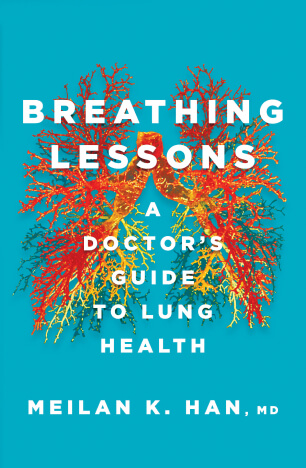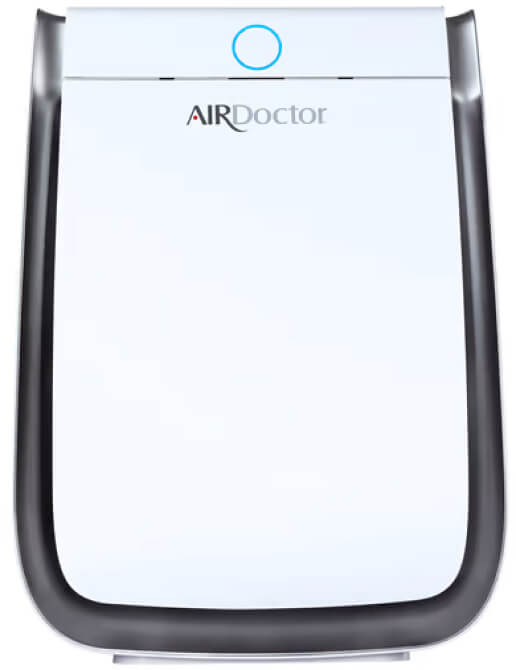Why Do We Overlook Our Lung Health? ist die Überschrift der Nachrichten, die der Autor von NachrichtenStar diesen Artikel gesammelt hat. Bleiben Sie auf NachrichtenStar auf dem Laufenden, um die neuesten Nachrichten zu diesem Thema zu erhalten. Wir bitten Sie, uns in sozialen Netzwerken zu folgen.


Supported by Science
Why Do We Overlook Our Lung Health?
Why Do We Overlook Our Lung Health?

Most of us rarely think about the health of our lungs and have never gotten a lung function test. But our lung health affects how we respond to respiratory infections, including COVID, and it is impacted by air pollution, wildfire smoke, and nutrition. Pulmonologist MeiLan Han, MD, chief of pulmonary and critical care at the University of Michigan, says, “Based on emerging evidence, I believe that lung inflammation is a risk factor for getting COVID and long-haul COVID.”
Han encourages us to ask our doctors for a simple breathing test to get an idea of how well our lungs are functioning. And if you’ve been diagnosed with COPD (chronic obstructive pulmonary disease) or asthma, she says to ask for diagnostic tests to confirm the diagnosis. In her book, Breathing Lessons: A Doctor’s Guide to Lung Health, Han describes how lungs work, how to care for them (from pregnancy through childhood and adulthood), and how our lungs are affected by vaping, viruses, and other environmental factors.
-
 MeiLan K. Han, MD
MeiLan K. Han, MD
Breathing Lessons
Bookshop, $23SHOP NOW
A Q&A with MeiLan K. Han, MD
Unfortunately, routine measurement of lung function was never adopted by physicians as part of standard medical practice in the US. We also don’t have great agreement on how to identify patients who should be screened for lung disease. Physicians should be asking patients about hazardous respiratory exposures, shortness of breath, and changes in exercise capacity. And if there’s a hint that there’s something going on, doctors should order a test of lung function. But often this doesn’t happen. That’s why it’s so important that people arm themselves with information.
Even a lot of patients with presumed lung disease aren’t undergoing appropriate diagnostic testing. Doctors frequently assume a patient has asthma or COPD based on symptoms alone. They proceed to treat as opposed to doing diagnostic testing, which would be unheard of for other diseases. You wouldn’t be given a diabetes diagnosis without a blood test. You wouldn’t be told you have high blood pressure without someone measuring your blood pressure first. But we do it with lung disease all the time.
The most basic test to ask for is spirometry, a simple test of lung function. We use a device called a spirometer that people blow into. It measures how much air an individual breathes out and how quickly they get it out. If there is any impairment, we have fancier breathing tests that use more-complicated machinery. We can also do additional testing, including CT scans of the chest, but spirometry is usually the first step.
If you’re noticing that you’re short of breath with regular activities, are coughing, can’t keep up with other people your age, or can’t do as much as you used to, you shouldn’t just chalk it up to having been inactive because of the pandemic. Certainly, you can give yourself some time to work on it, but if it doesn’t seem to change, then you want to mention this to your physician, because physicians are not necessarily going to ask you proactively about your lungs. It’s not on their checklist. And then push them for spirometry.
My best guess is that probably about half do. Some primary care physicians are not comfortable with interpreting the test results. While the device is simple, staff need to be trained on how to help patients do the tests. So physicians have to make it a priority. If your own doctor doesn’t have the device in their office and isn’t comfortable doing the test, it’s not hard to find elsewhere. Most hospitals have a pulmonary function lab, and it’s a quick and painless test.
Our lungs form in three stages. There is a critical period in the womb when what a mother eats and what she is exposed to are important. A Mediterranean diet has been shown to be helpful for fetal lungs. On the other hand, evidence suggests that exposure to nicotine may cause fetal lungs to develop abnormally, increasing the risk of abnormal lung function, respiratory infections, and childhood asthma. Even maternal air pollution exposure during pregnancy increases the risk of impaired fetal lung development.
During childhood, your lungs are slowly developing, and peak function doesn’t happen until twenty-five. What we’re finding is that about half of individuals with one of the most common adult lung diseases, COPD, never attained predicted peak lung function in the first place. Most physicians previously thought that without an event such as premature birth, children would have normal lung function at adulthood.
But this data suggests there are probably millions of children who are not reaching peak lung function. We think this is likely due to a combination of factors, including premature birth, repeated respiratory infections, and other exposures such as secondhand smoke and air pollution. As a mom, that is something I think about a lot. For instance, it’s important that your children receive age-appropriate vaccinations to protect them as best you can against respiratory infections. We still don’t know what the long-term effects will be for children who have had COVID.
In addition to protecting children from factors that may harm their respiratory health, there’s interesting data to suggest that you can do some things that are proactive. One study found that good cardiovascular fitness in young adulthood is associated with better lung function much later in life. Vitamin D is also important for immune function. Vitamin D may benefit respiratory health, particularly among individuals who are deficient.
Based on emerging evidence, I believe that lung inflammation is a risk factor for getting COVID and long-haul COVID. We have learned that individuals in Oregon who were exposed to wildfire smoke had significantly more COVID cases and deaths than those who were not exposed to wildfire smoke. The thinking is that the wildfire smoke causes inflammation in the lungs, which may increase your susceptibility to infections.
The other data that’s come out recently is from scientists at the University of Michigan who found that some people with long-haul COVID had undiagnosed lung inflammation evident on chest CT scans before they developed COVID. I believe that preexisting lung inflammation may help explain why some people are getting COVID and some are not, and why some people are getting long-haul COVID and some are not.
If you absolutely have to spend significant time outside during periods of intense air pollution, wear a mask. An N95 mask is required to filter out the airborne particles we worry about. Running a HEPA filter in your home on days when the air is bad also makes a lot of sense.
Editors’ Pick:
HEPA Filter
-
 Air Doctor
Air Doctor
4-IN-1 AIR PURIFIER
goop, $498SHOP NOW
The newer models of wood-burning stoves that meet the new EPA standards are definitely better than older models. Older, uncertified stoves release fifteen to thirty grams of smoke per hour! I grew up in Idaho with a wood-burning stove, and I know this is still common for heating in the winter in parts of the US. If you do have a wood-burning stove in your home, it would be best to have a unit that meets the 2020 EPA standards, which limit emissions to two grams of smoke per hour. However, even newer models will still contribute to indoor air pollution.
Volatile organic compounds are a major source of indoor air pollution. Some VOCs can cause a variety of health problems, including respiratory symptoms and worsening of asthma. VOCs are emitted as gases from household products including paints, cleansers, dry-cleaned clothing, pesticides, and even craft materials. To reduce your exposure, use low-VOC paints when you can. If possible, have carpets aired out before they’re installed. Try to increase ventilation when using products that emit VOCs.
Other causes of air pollution in the home include carbon monoxide and radon. Make sure you have carbon monoxide detectors and that your home has been checked for radon. Something else I haven’t been good about doing, but now I’m trying to be religious about, is running the exhaust fan whenever I cook. Gas stoves in particular can release harmful pollutants, as can the food cooking process itself.
{„sizes“:{„mobile“:[[300,250]],“tablet“:[[300,250]],“desktop“:[]},“targeting“:{„pos“:“rightrail“},“adUnit“:“/55303442/ros“}
That absolutely is something we need to think about. The EPA has a list of cleaning products that meet the new, safer choice requirements, and that would be a good place to start. We know that occupational exposures are associated with increased risk for lung disease. The ones that people typically think about are coal miners or firefighters. But people who work in hair salons and nail technicians are also exposed to potentially toxic compounds.
Many health and beauty products also contain VOCs. Some hair straighteners contain formaldehyde. Nail polish can contain toluene, which has been linked to respiratory toxicity. Asbestos has been found in glittery makeup products marketed to young girls and in talc-based products like blush. As a consumer, it can be very difficult to figure out which products are safe. Reading labels and sticking to fewer products with shorter ingredient lists is one strategy. [Editors’ note: At goop, all products sold in the clean beauty shop are made without a long (and ever-evolving) list of ingredients linked to harmful health effects. For more information, the Environmental Working Group has evaluated the safety of ingredients in cosmetics, cleaning products, and more.]
Unfortunately, there are still a fair number of carcinogens and toxic compounds that are either in vaping liquid to begin with or are produced through the vaping process. We don’t have the same degree of long-term data on the ill effects of e-cigarettes on respiratory health that we have for combustible cigarettes. However, based on what is in them, we remain concerned about their potential for causing lung inflammation and cancer.
E-cigarettes also contain high levels of nicotine. In women who are pregnant, exposure to nicotine can alter airway development of the fetus. Nicotine causes fetal airways to develop to be longer and more tortuous than normal, and this could predispose the fetus to asthma. Because of this, vaping isn’t a safe option for pregnant women. With conventional cigarettes, there is some data to suggest that if you can’t quit smoking during pregnancy, vitamin C supplementation may be helpful in protecting fetal lungs.
There is less evidence that smoking marijuana over the long-term has negative effects on the lungs. The data is mixed. One of the reasons it’s hard to quantify lung damage from marijuana is that many people who smoke marijuana also smoke cigarettes and vape other things. So it has been difficult to tease out effects of inhaled marijuana on the lungs.
If you’re not sure about the outdoor air quality in your area, there is a website I like called AirNow.gov. Sometimes you can’t pick when you’re going to work or exercise outside, but on the days you can, try to reduce time outside on days when the air quality is bad. Put your car on recirculate as opposed to letting fresh air in on bad-air days.
There is evidence to suggest that living or going to school near freeways can be associated with asthma in children. Poor lung function can improve when children are moved out of that environment. While you can’t always control where your child’s school is, you may be able to ask the school to adopt anti-idling policies. You can get an idle-free schools toolkit from the EPA. As a mother, I’m well aware that the pickup lines have become insane during the pandemic, and anything the school can do to reduce exposure to auto emissions will improve lung health for children. If you live in an area where there is frequently poor air quality, the school may be able to focus on indoor exercise as opposed to outdoor exercise activities.
MeiLan K. Han, MD, is professor of medicine and chief of pulmonary and critical care at the University of Michigan, a spokesperson for the American Lung Association, and the author of Breathing Lessons: A Doctor’s Guide to Lung Health. She received her medical degree from the University of Washington in Seattle and completed her residency in internal medicine and fellowship in pulmonary and critical care medicine at the University of Michigan. Han directs NIH-sponsored research on chronic obstructive pulmonary disease (COPD).
This article is for informational purposes only. It is not, nor is it intended to be, a substitute for professional medical advice, diagnosis, or treatment and should never be relied upon for specific medical advice. To the extent that this article features the advice of physicians or medical practitioners, the views expressed are the views of the cited expert and do not necessarily represent the views of goop.
We hope you enjoy the book recommended here. Our goal is to suggest only things we love and think you might, as well. We also like transparency, so, full disclosure: We may collect a share of sales or other compensation if you purchase through the external links on this page.










